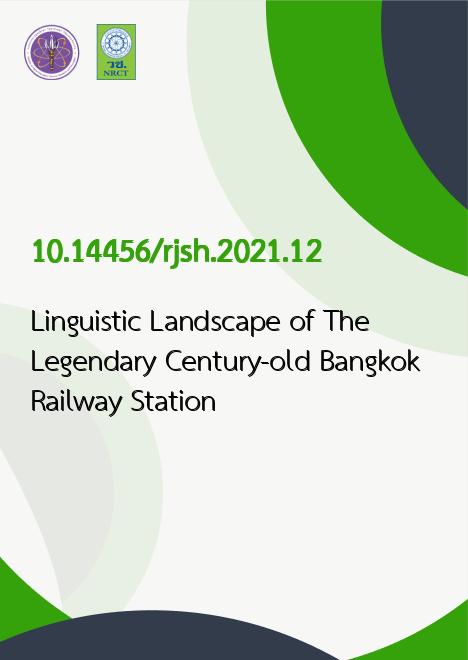
|
Linguistic Landscape of The Legendary Century-old Bangkok Railway Station |
|---|---|
| รหัสดีโอไอ | |
| Creator | Piyarat Pipattarasakul |
| Title | Linguistic Landscape of The Legendary Century-old Bangkok Railway Station |
| Publisher | Rangsit University |
| Publication Year | 2564 |
| Journal Title | Rangsit Journal of Social Sciences and Humanities |
| Journal Vol. | 8 |
| Journal No. | 2 |
| Page no. | 52-65 |
| Keyword | language diversity, language functions, linguistic landscape, Query by Example, railway stations, top-down and bottom-up approach |
| URL Website | https://rjsh.rsu.ac.th/ |
| Website title | Rangsit Journal of Social Sciences and Humanities |
| ISSN | 2286-976X |
| Abstract | Linguistic landscape (LL) has been gaining ground because of an interest in multilingualism and globalization tendencies where languages interact in establishing a global environment. Studies of LL help improve images and services provided by the government and commercial organizations. In line with this, this paper proposes a computerized method of examining the linguistic landscape of the Bangkok Railway Station, known as Hua Lamphong Railway Station, in terms of language use and functions. Moreover, a top-down and bottom-up approach was used to analyze the organizations that created the signs. A total of 314 signs were collected and their contents were stored in a database. Then, the Query by Example (QBE) approach was applied to generate information based on the languages on the signs and their categories. The results showed that the following seven foreign languages were found: English, Chinese, French, Japanese, Burmese, Bahasa Melayu, and Yawee. Thai was the most predominant language used in this station, and English was the foreign language that was mostly used to help create a global environment. The signs were used for providing general information, giving direction, advertising, preventing diseases, prohibition, warning, conveying greetings, and welfare messages. Most of the signs were produced by government agencies, followed by companies, and then local shops. The image of the Bangkok Railway Station can be enhanced through cooperation between the public and private sectors and multilingualism should be promoted for more effective communication. Apart from creating a larger scale research opportunity, our proposed method could efficiently provide insights into linguistic diversity and the functions of language on signs. Importantly, the results can be applied to improve communication on signs for other railway stations throughout the country. |